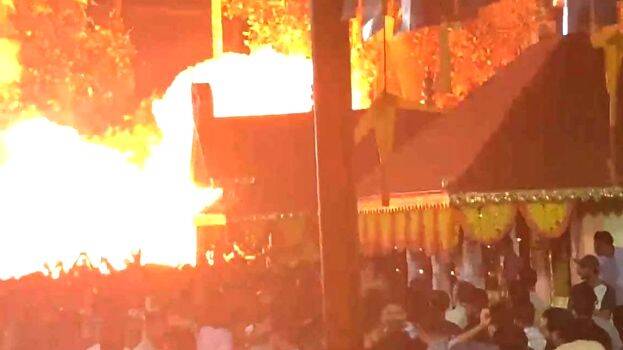

Fireworks are called 'Agnikreeda' in Sanskrit! When translated to Malayalam it means "game of fire". Fireworks in violation of rules and regulations, whether in connection with rituals or as part of celebrations, are definitely a game of fire. In Kerala, fireworks are common not only in connection with temples but also as part of church festivals and even as part of celebrations that have nothing to do with places of worship. Small and big fireworks accidents during the festive season were common year after year. The most recent tragedy in that row is the fireworks accident that occurred at Neeleswaram in Kasaragod in the wee hours yesterday during 'Kaliyattam' at the temple. As many as 154 people are being treated in hospitals with burn injuries and injuries sustained while running in panic. The condition of more than 15 of them is reported to be critical.
Although there was no loss of life, the application of pyrotechnics, carried out in violation of all restrictions without statutory permissions, and not even three metres away from the fireworks store room, at the festival venue which was packed with thousands of people including women and children, could have easily turned into a catastrophe. Though fireworks take place here every year in connection with 'Kaliyattam', it used to be conducted across a sacred grove(Kavu) near the temple. This time, pyrotechnics was moved to the vicinity of the fireworks store room to prevent the Kavu from becoming an obstacle to the extravaganza of the fireworks show. This, however, resulted in an accident. The police have registered a case against eight people, including temple officials and fireworks operators, for using pyrotechnics without permission and without ensuring safety. Three of them have been arrested.
The Neeleswaram accident is a reminder that 'don't play with fire' is not just an expression and that any kind of fireworks, big or small, should be held at a safe distance, in permissible quantities, adhering to all safety norms. It has not been weeks since the central government issued a notification revising the provisions of the Explosives Act relating to matters including the manufacture, storage and application of explosives. The new notification, which includes 35 types of amendments, stipulates that there should be a distance of 200 metres between the place where firecrackers are stored and the place where the fireworks display will take place. At present, this distance limit is only 45 meters. The new amendment comes at a time when devaswoms and temple committees are demanding that this distance limit itself is high and it should be reduced. The state cabinet meeting, which assessed that such stringent restrictions would adversely affect the conduct of fireworks associated with places of worship, has also written to the central government seeking relaxations.
Grandeur, pomp and splendour are good for the festive celebrations. When it comes to fireworks, the devaswoms and pyrotechnicians will bring out their best works by adding up the potency of all these to surprise the crowd. However, it is the responsibility of the organisers and the government to ensure repeatedly that any endeavour is in accordance with the existing rules and that the safety of those who come to watch the festival is fully ensured. There are a number of conditions to be followed in connection with the fireworks, such as permission from the district collector, police permission, fire safety certificate, police supervision at the site, etc. The authorities often turn a blind eye to all this as it is related to a place of worship! Let the Neeleswaram fireworks accident once again remind us of the dangers that such carelessness, compromises and insouciance can cause.